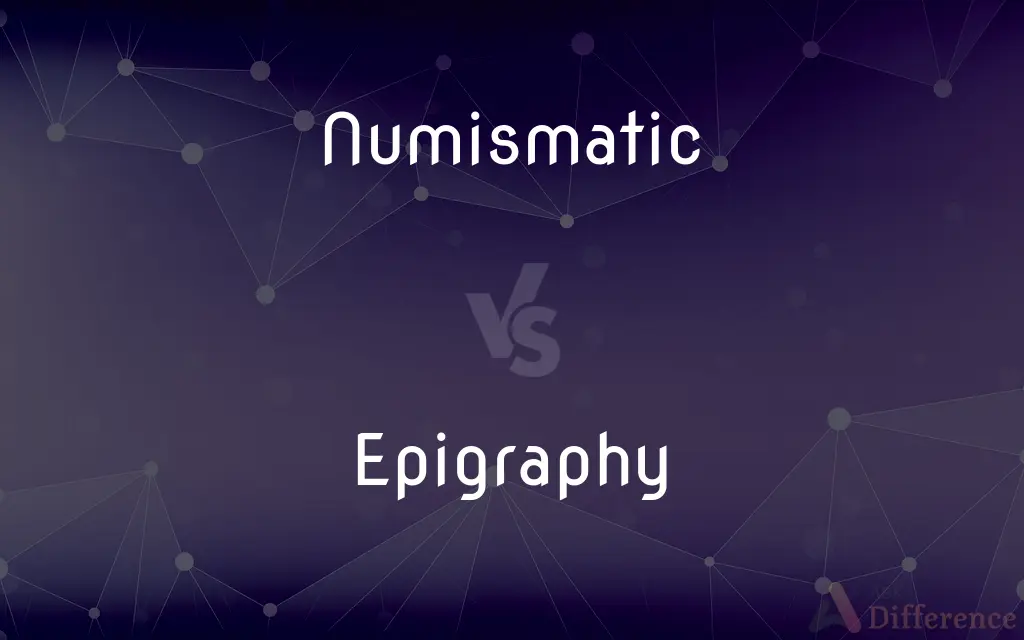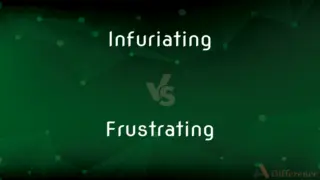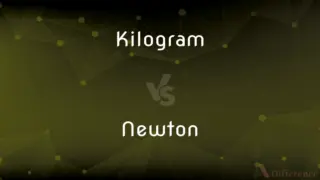Numismatic vs. Epigraphy — What's the Difference?
By Tayyaba Rehman & Maham Liaqat — Updated on April 24, 2024
Numismatics involves the study and collection of currency, including coins, tokens, paper money, and related objects. Epigraphy deals with the study of inscriptions or epigraphs as written on hard substances like stone, metal, or ceramics.

Difference Between Numismatic and Epigraphy
Table of Contents
ADVERTISEMENT
Key Differences
Numismatics is centered on the study of coins and other forms of minted legal currency. It examines aspects like the material, mint marks, inscriptions, and aesthetic designs, which reveal much about the historical and economic contexts of their time. Whereas, epigraphy focuses on inscriptions made on durable materials such as stone or metal, studying the language, script, and historical records that are often crucial for understanding ancient civilizations.
In numismatics, the rarity and condition of the coins are critical factors that determine their value and significance, often making rare specimens particularly valuable to collectors and historians alike. On the other hand, epigraphy values the content and historical significance of inscriptions, which can provide unique insights into legal, religious, and social practices of the past.
Researchers in numismatics often employ tools like magnifying glasses and microscopes to analyze the minute details of coins, assessing aspects like wear and artistic style to determine their origins and historical context. Conversely, epigraphists use tools such as silicone molds and rubbings to capture and study the fine details of inscriptions without damaging the original artifact.
Numismatics can also involve the collection and study of paper money, medals, and tokens, extending beyond coins to include a wide range of monetary items. Epigraphy, however, strictly deals with texts engraved or embossed on hard materials, often excluding any written records on perishable materials like paper.
The findings in numismatics can influence economic history, helping historians trace trade routes and economic stability. Meanwhile, epigraphic discoveries often impact the understanding of linguistic development, political history, and the diffusion of cultures.
ADVERTISEMENT
Comparison Chart
Definition
The study of coins and currency.
The study of inscriptions written on durable materials.
Focus
Coins, tokens, medals, and paper money.
Inscriptions on stone, metal, and other hard substances.
Tools Used
Magnifying glasses, microscopes.
Molds, rubbings, digital imaging.
Main Contribution
Economic history, design evolution.
Linguistic, cultural, and legal history.
Typical Materials Studied
Metal, paper.
Stone, metal.
Compare with Definitions
Numismatic
Collector's hobby.
His interest in numismatics began with a rare 19th-century coin he found in his backyard.
Epigraphy
Cultural research.
Through epigraphy, researchers uncovered a previously unknown ceremonial practice.
Numismatic
Economic indicator.
Numismatics can reveal much about the economic conditions of a historical period.
Epigraphy
Archaeological tool.
Epigraphy provides critical data for archaeological site interpretations.
Numismatic
Educational field.
Numismatics is taught as part of many university history and archaeology programs.
Epigraphy
Inscription study.
Epigraphy involves deciphering ancient scripts carved in stone.
Numismatic
Study of currency.
Numismatics often examines the evolution of coin designs over centuries.
Epigraphy
Historical documentation.
Epigraphy has uncovered governmental decrees from ancient times.
Numismatic
Artifact analysis.
In numismatics, the analysis of a coin’s wear and tear can indicate its age and circulation history.
Epigraphy
Linguistic analysis.
Epigraphy helps linguists trace the development of languages over millennia.
Numismatic
Of or relating to coins or currency.
Epigraphy
Epigraphy (Ancient Greek: ἐπιγραφή, "inscription") is the study of inscriptions, or epigraphs, as writing; it is the science of identifying graphemes, clarifying their meanings, classifying their uses according to dates and cultural contexts, and drawing conclusions about the writing and the writers. Specifically excluded from epigraphy are the historical significance of an epigraph as a document and the artistic value of a literary composition.
Numismatic
Of or relating to numismatics.
Epigraphy
Inscriptions considered as a group.
Numismatic
Of or pertaining to currency, especially to coins.
Epigraphy
The study of inscriptions.
Numismatic
Of or pertaining to numismatics.
Epigraphy
Decipherment, especially of ancient inscriptions.
Numismatic
Of or pertaining to coins; relating to the science of coins or medals.
Epigraphy
Inscriptions collectively.
Epigraphy
The study or decipherment of inscriptions, especially of ancient ones.
Epigraphy
The science of inscriptions; the art of engraving inscriptions or of deciphering them.
Epigraphy
The study of ancient inscriptions
Common Curiosities
How do numismatics and epigraphy differ in focus?
Numismatics focuses on monetary items, while epigraphy focuses on inscribed texts.
What tools are essential in epigraphy?
Epigraphy often uses tools like silicone molds and digital imaging to study inscriptions.
What does epigraphy study?
Epigraphy studies inscriptions written on durable materials like stone and metal.
How does epigraphy contribute to historical understanding?
Epigraphy provides insights into linguistic, cultural, and legal histories.
What is numismatics?
Numismatics is the study and collection of currency, including coins, tokens, and paper money.
How has digital technology impacted epigraphy?
Digital technology has revolutionized epigraphy by improving accuracy and accessibility of inscriptions.
What materials are studied in numismatics?
Numismatics studies materials like metals and paper.
How is the rarity of items viewed differently in numismatics vs. epigraphy?
In numismatics, rarity often enhances value; in epigraphy, the content's historical significance is more crucial.
What tools are commonly used in numismatics?
Tools such as magnifying glasses and microscopes are common in numismatics.
What are the typical materials studied in epigraphy?
Epigraphy studies durable materials such as stone and metal.
Can numismatics provide economic insights?
Yes, numismatics can reveal historical trade routes and economic conditions.
What educational backgrounds support a career in numismatics?
Backgrounds in history, economics, and archaeology support numismatics.
Are there digital tools used in numismatics?
Yes, digital tools are increasingly used to analyze and catalog coins.
What is a common goal of both numismatics and epigraphy?
Both fields aim to enhance our understanding of historical contexts and cultural developments.
What educational paths are ideal for pursuing epigraphy?
Studies in linguistics, history, and archaeology are ideal for epigraphy.
Share Your Discovery

Previous Comparison
Infuriating vs. Frustrating
Next Comparison
Kilogram vs. NewtonAuthor Spotlight
Written by
Tayyaba RehmanTayyaba Rehman is a distinguished writer, currently serving as a primary contributor to askdifference.com. As a researcher in semantics and etymology, Tayyaba's passion for the complexity of languages and their distinctions has found a perfect home on the platform. Tayyaba delves into the intricacies of language, distinguishing between commonly confused words and phrases, thereby providing clarity for readers worldwide.
Co-written by
Maham Liaqat













































